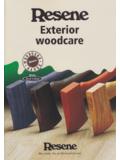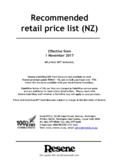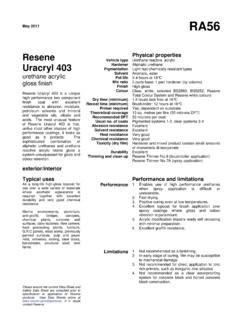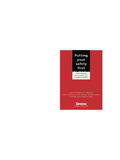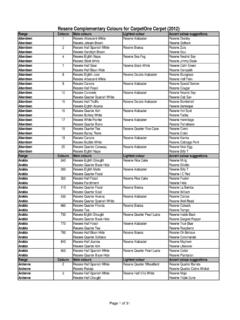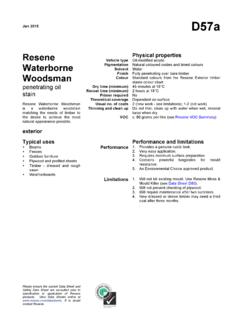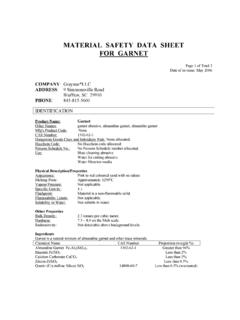Transcription of Resene Waterborne Uracryl 802 | RA55W - Technical …
1 Apr 2013 RA55W Resene Waterborne Uracryl 802 Waterborne urethane acrylic semi-gloss finish Resene Waterborne Uracryl 802 is a Waterborne high performance two component semi-gloss finish with excellent resistance to abrasion, moisture, petroleum solvents and mineral and vegetable oils. The most unusual feature of Resene Waterborne Uracryl 802 is that, unlike other classes of high performance coatings, it looks as good as it protects and is unsurpassed for durability and colour retention. exterior/interior Vehicle type Hardener Pigmentation Solvent Pot life Mix ratio Induction time Finish Colour Dry time (minimum) Recoat time (minimum) Primer required Theoretical coverage Recommended DFT Usual no.
2 Of coats Chemical resistance Heat resistance Solvent resistance Toxicity Thinning Clean up VOC Physical properties Reactive acrylic Polyisocyanate Titanium dioxide/light fast chemically resistant types Water/ester/glycol ether 2 hours at 18 C (see limitations) 5:1 (by volume) 10-15 minutes Semi-gloss White, selected BS381C, BS5252, Resene Total Colour System and Resene Whites & Neutrals Tack free: 2 hours at 18 C 3 hours at 18 C. Maximum: 2 weeks at 18 C. Can be recoated when applied film does not retain a fingerprint when pressed. Yes (ferrous and non-ferrous metal substrates, including galvanising/Zincalume and zinc rich paints). 12 sq. metres per litre at 38 microns DFT (thinned 5%) 75 microns (minimum 2 coat application required) 2 (dependent upon substrate and porosity) Very good (acid/alcohol) Very good Excellent (see performance) Hardener and mixed product contain small amounts of monomeric di-isocyanate Water only.
3 Do not thin with glycol containing thinners including Resene Hot Weather Additive. Clean up with warm water and detergent immediately after use. Application equipment will be irrevocably damaged if uncured product is not thoroughly removed (wet paint). 69 grams per litre when mixed and unthinned (see Resene VOC Summary) Typical uses Performance and limitations As a long life semi-gloss topcoat for use over a wide variety of materials where colour retention is required together with excellent durability and very good chemical resistance. Performance 1. Waterborne formulation. 2. Enables use of high performance urethanes when spray application is difficult or undesirable.
4 3. Semi-gloss pigmented anti-graffiti coating. 4. Excellent exterior durability. Marine environments, aluminum, anti graffiti, chemical plants, concrete wall surfaces, dairy factories, fibre cement, food processing plants, GRC panels, hotel and motel rooms, meat works, office blocks, pulp and paper mills, roofing, structural steel, galvanising. Please ensure the current Data Sheet and Safety Data Sheet are consulted prior to specification or application of Resene products. View Data Sheets online at If in doubt contact Resene . Limitations 1. In early stages of curing, film may be susceptible to mechanical damage. 2. Not recommended for immersion use.
5 3. Not recommended for direct application to Resene Vinyl Etch (see Data Sheet RA31), Resene ConcreteSeal 3 in 1 (Data Sheet D409) or inorganic zinc silicates such as Resene Zincilate 11 (see Data Sheet RA21). 4. Do not apply at temperatures below 10 C and relative humidity greater than 85% or when these conditions exist during drying/curing. Please ensure the current Data Sheet is consulted prior to specification or application of Resene products. If the surface you propose to coat is not referred to by this Data Sheet, please contact Resene for clarification. In Australia PO Box 924, Beenleigh, Qld 4207 Call 1800 738 383, visit or email In New Zealand PO Box 38242, Wellington Mail Centre, Lower Hutt 5045 Call 0800 Resene (737 363), visit or email Printed on environmentally responsible paper, which complies with the requirements of environmental management systems EMAS and ISO14001.
6 Please recycle. Waterborne Uracryl 802 urethane acrylic Surface preparation Concrete: Leave new concrete to cure for a minimum of 28 days before painting. Surfaces shall be free of laitance, form release agents, curing agents, oil, grease and other penetrating contaminants. Concrete floors must be profiled by captive blasting, abrasive blasting, diamond grinding, or acid etching (see Data Sheet D83). Profiling should produce a profile similar to 180 grit sandpaper. If this is not achieved, repeat the profiling process. After profiling fill all small holes or voids by application of Resene Epox-O-Bond (see Data Sheet D808). Use of Resene Epox-O-Bond filler is only suitable when finishing with pigmented Resene Uracryl systems.
7 Seal concrete with Resene Aquapoxy Gloss (see Data Sheet RA42) thinned 10%. Fibre cement: Clean down to remove all dirt, dust and loose material. Ensure surface is free from oil, grease and mould. Seal with Resene Aquapoxy Gloss (see Data Sheet RA42) thinned 10%. Allow to cure for 24 hours then lightly sand surface to remove raised fibres. Galvanised steel, Zincalume, aluminium and repaints: Remove oil or grease film with Resene Roof and Metal Wash (see Data Sheet D88) and rinse thoroughly. Prime with Resene Armourcote 220 (see Data Sheet RA34) or Resene Armourcote 221 (see Data Sheet RA36). Particle board, timber: Sand to establish a smooth clean surface. Stop all nailholes, joints and other surface irregularities.
8 Prime with Resene Quick Dry Waterborne primer undercoat (see Data Sheet D45). Steel: Degrease according to SSPC SP1 solvent cleaning. Remove all weld spatter, grind weld seams and sharp edges. Ensure complete removal of all weld flux by wire brushing followed by washing with copious quantities of freshwater. Dry abrasive blast to a minimum of SSPC SP10 (Sa ). Blast to achieve a 25-50 micron anchor profile. Apply zinc rich or epoxy primer (see Limitations). Residues and dust from old paint systems containing lead or chromate may be dangerous to the health of the operator and the environment. Ensure approved procedures are put in place to safeguard against this. Application Mixing Add total contents of hardener container to total contents of base.
9 Mix until uniformly blended using a wide flat stirrer or power mixing. Back add the mixed material to the hardener container (approximately two thirds full) and hand mix or re-lid and shake for 1-2 minutes to incorporate any hardener that was not decanted in the first instance. Add this back to the previously mixed paint and re-mix until uniform. Thin with 5% fresh water to achieve desired consistency and allow the mixed material to stand for 10 minutes prior to using. Application Apply by roller ( Resene sleeve), synthetic brush or spray. When rolling, work in a continuous direction and immediately lay-off with a 50% overlap, tip-off with a brush if bubbles persist. Avoid working back over areas that have begun to dry as this will lead to a patchy finish.
10 Thin only with water when applying under hot or windy conditions. Care is advised when applying thinned product as sag of the wet film may occur. GASSING WILL OCCUR IF UNTHINNED PRODUCT IS APPLIED AT WET FILM THICKNESSES IN EXCESS OF 125 MICRONS. When applying thinned product maximum wet film thickness to avoid gassing is dependent upon the amount of water added. Do not use mixed product beyond the stated pot life for the given temperature. CAUTION Do not tightly re-seal quantities of leftover mixed product, as the mixed product generates carbon dioxide gas, which can cause the lid of a tightly sealed can to pop with force. Leave the mixed material in a safe place for at least 48 hours for outgassing to be completed before sealing cans for disposal through a Resene PaintWise location or approved hazard waste site.
